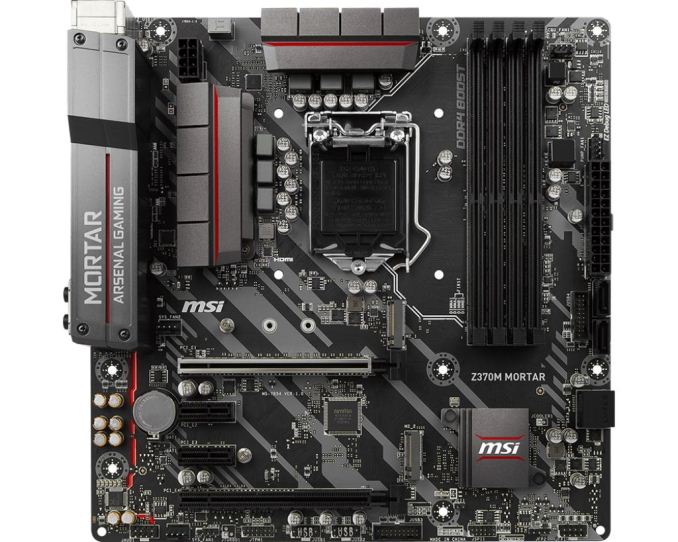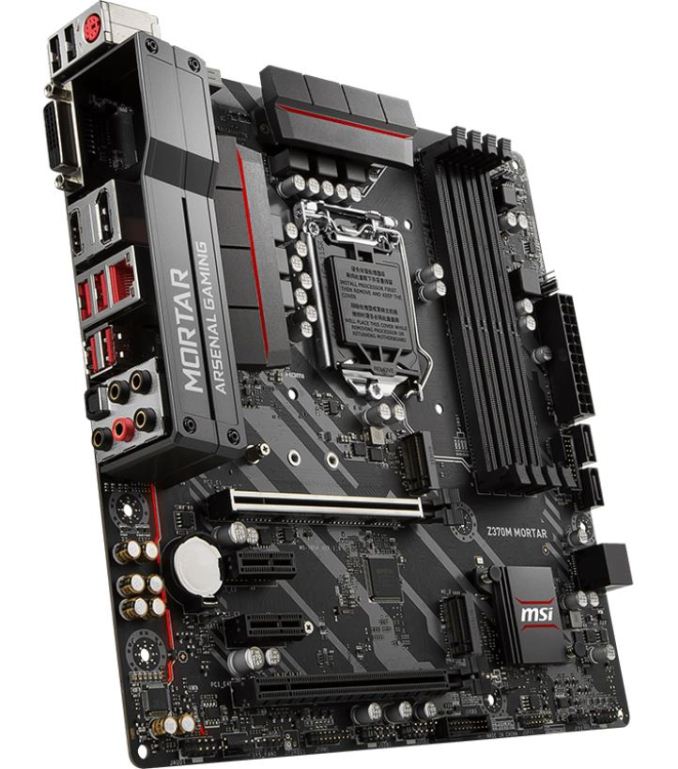Analyzing Z370 for Intel's 8th Generation Coffee Lake: A Quick Look at 50+ Motherboards
by Ian Cutress, Anton Shilov, Joe Shields & Gavin Bonshor on October 20, 2017 2:00 PM ESTMSI Z370M Mortar
The Mortar’s appearance does have a more rugged look compared to the other MSI micro-ATX board, the Z370M Gaming Pro AC. The Mortar’s back panel cover looks like it was taken from a military vehicle with the aesthetic only screws on both ends giving it an industrial feel. The heatsinks are simple grey with a red line through the middle, in contrast to the jet black PCB that has some grey design features on the board. There are no onboard RGB LEDs, with the only support provided through an onboard header. A single full-length PCIe slot is reinforced, with the focus for this board on single GPU setups. The PCH heatsink is a diminutive piece with the MSI name on it in white letters with red accents and is attached via pushpins.
MSI still uses all four memory slots here, capable of up to 64 GB and on-the-box speeds of DDR4-4000. Despite the industrial feel to the board, there is no memory slot reinforcement here, and MSI has used dual-sided latch mechanisms over the single-sided latch versions we sometimes see on high-end motherboards. For PCIe, the top reinforced slot handles the main add-in card duty, supporting PCIe 3.0 x16 direct from the processor. The other full-length slot is a PCIe x4 slot from the chipset, and the board also has two smaller PCIe x1 slots in between.
As with the other MSI micro-ATX board, there is only four SATA ports here, with two in a 'regular' position and the other two sitting vertically on the board just below the 24-pin ATX connector. These last two are also right next to a USB 3.0 internal header, and in a position that might make it difficult to release locking SATA cables if a front panel cable is attached to the USB 3.0 header. Other storage comes via dual M.2 slots, with the Mortar supporting 80mm drives in both, however, the first slot is PCIe only, with the second slot able to do both PCIe and SATA.
The Mortar will accept a total of four fans with its 4-pin headers, two of which are located around the chipset. The 4-pin headers support both PWM and voltage control. Network connectivity is through a sole Intel I219-V gigabit Ethernet controller, with the price of this board meaning that Wi-Fi is not present. The audio codec is also lower than 'normal' to save a few pennies, however the Realtek ALC892 codec still offers 7.1 channel support. MSI has at least offered some PCB separation to reduce electrical interference with the audio paths.
USB Support for the Mortar is missing the latest USB 3.1 (10 Gbps), but it has a total of eight USB 3.1 (5 Gbps) ports: there are four Type-A on the back panel, and four more available through the two internal headers. The board also has two USB 2.0 ports on the back panel and two internal headers. The rest of the Mortar’s panel consists of a combination PS/2 port, DVI-D/HDMI/DisplayPort video outputs, the network connection, and the audio jacks with SPDIF.
| MSI Z370M Mortar | |
| Warranty Period | 3 Years |
| Product Page | Link |
| Price | N/A |
| Size | Micro-ATX |
| CPU Interface | LGA1151 |
| Chipset | Intel Z370 Express |
| Memory Slots (DDR4) | Four DDR4 Supporting 64GB Dual Channel Support DDR4 4000+ |
| Network Connectivity | 1 x Intel I219-V |
| Onboard Audio | Realtek ALC892 |
| PCIe from CPU | 1 x PCIe 3.0 x16 slots |
| PCIe from Chipset | 1 x PCIe 3.0 x4 2 x PCIe 3.0 x1 slots |
| Onboard SATA | 4 x Supporting RAID 0/1/5/10 |
| Onboard SATA Express | None |
| Onboard M.2 | 2 x PCIe 3.0 x4 Slot 1 PCIe only Slot 2 PCIe or SATA |
| Onboard U.2 | None |
| USB 3.1 (10 Gbps) | N/A |
| USB 3.1 (5 Gbps) | 4 x Back Panel 2 x Headers |
| USB 2.0 | 2 x Back Panel 2 x Headers |
| Power Connectors | 1 x 24-pin EATX 1 x 8-pin ATX 12V |
| Fan Headers | 1 x 4-pin CPU 1 x 4-pin Waterpump 2 x 4-pin System Fan (All PWM or Voltage controlled) |
| IO Panel | 1 x Combination PS/2 2 x USB 2.0 1 x DisplayPort 1 x DVI-D port 1 x HDMI port 1 x LAN (RJ45) port 4 x USB 3.1 (5 Gbps) Type-A ports 5 x Audio Jacks + SPDIF |












83 Comments
View All Comments
sor - Friday, October 20, 2017 - link
Damn. At least key it differently and call it LGA1151v2 or something.The changes are so minimal it really does seem like planned obsolescence. Does it really need more power pins to support new chips with the same power envelopes? Really? They couldn’t handle that on the CPU PCB?
KaarlisK - Saturday, October 21, 2017 - link
Actually it is ~1.5 times peak current with the same average power envelope, so yes, they need the change.If they had not brought the launch forward and just launched together with the cheap chipsets, there would be far less complaints.
sor - Saturday, October 21, 2017 - link
Where did you find information indicating current has increased 50%? I just spent about ten minutes trying to find a reference backing that up, perhaps something indicating the 8 series operates at a much lower voltage within same TDP, which would translate to higher current but they seem to operate in the same 1.2-1.3v range.You’re not just assuming they draw more current because they have two more cores, are you?
KaarlisK - Sunday, October 22, 2017 - link
Notice the difference between average and peak.And the information is in publicly available documents. I did not bother to look it up, but others have, for example: https://forum.beyond3d.com/threads/intel-coffee-la...
Crono - Saturday, October 21, 2017 - link
Nice roundup. That's a lot of motherboards to spec and summarize. I especially appreciate the handy chart at the end, it's a good, quick-and-dirty comparison tool.Landcross - Saturday, October 21, 2017 - link
You guys forgot 2 new Z370 boards from Supermicro :)https://motherboarddb.com/motherboards/?chipset=19...
Xpl1c1t - Sunday, October 22, 2017 - link
The mITX board looks incredible.+ Low ESR Tantalum capacitors! (first time seeing them on VRM duty on a mainboard)
+ HDMI 2.0
+ 2x M.2 Slots
+ USB 3.1 Type C
+ Optical SPDIF
- RGB.......
MadAd - Saturday, October 21, 2017 - link
Great write up but for me its just another depressing generation of oversized, overpriced ATX form factor offerings on which the vast majority of users wont even plug a second gpu into, with the smaller and more size appropriate FF represented as a minority afterthought.With all the progress of PCs since the 90s whod have thought that I could still use the same ATX case today while every single other component (from floppy drives to 2d Mattrox cards) have long gone to the recyclers. I find it so annoying how manufacturers have stuck on this prehistoric gargantuan case size with the other sizes being an afterthought. It feels like like stifled innovation while everything else is moving on.
rocky12345 - Saturday, October 21, 2017 - link
Great article and a lot of work put in to get it out for us to read thank you.My only issue is and it is nit your fault is why these companies feel the need to totally blanket the market with basically the same boards just a different model number and basically a few tiny changes and spray paint it a different color and use the word gaming and put something x or x1 or k,k3 etc etc. For crap sakes just release three models not 7-10 models of the same crap it is pretty much just greed I guess.
The whole market is like this now with anything computer related of and if it has the words GAMING or RGB in it's got to be good for sure. My fav is that gaming mouse pad next it will have RGB lighting in it...lol
CitizenZer0 - Wednesday, October 25, 2017 - link
Agreed